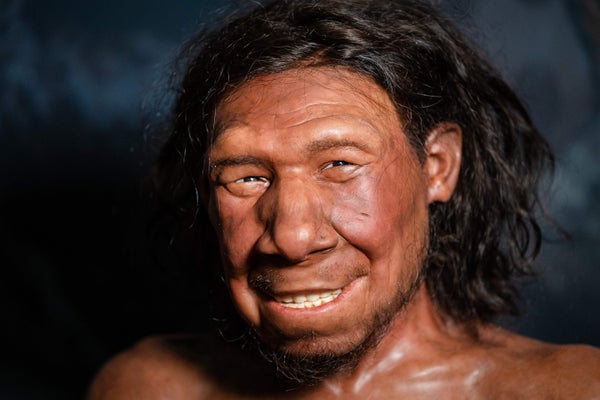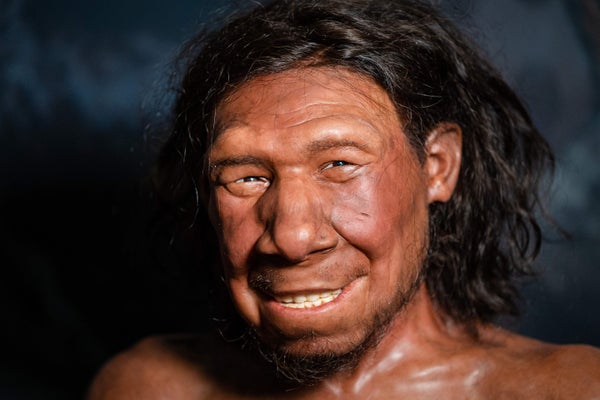October 11, 2024
4 min read
Humanity’s Origins Paint Our Ancestors as Lovers, Not Fighters
Fossil and gene discoveries paint an ever-more-intertwined history of humans combining with vanished species like Neandertals

The reconstructed face of Krijn, the oldest Neanderthal found in the Netherlands, displayed at the National Museum of Antiquities in Leiden on September 6, 2021.
Bart Maat/ANP/AFP via Getty Images
At the heart of scientific questions about the origins of humanity lie questions of human nature. Are Homo sapiens intrinsically lovers or fighters, predators or prey, lucky survivors or inevitable conquerors?
The friendlier answers to those queries keep coming, seen in a spate of genetic findings and some recent fossil discoveries. They also underline how tough life was for our prehistoric ancestors. Despite the eight billion people on Earth today, and counting, just surviving was winning for most of humanity’s history.
Not everyone did. Only 200,000 years ago, our ancestors lived on a planet teeming with varied human relatives: Neandertals lived in Europe and the Middle East. Denisovans, known today only from bone fragments, teeth and DNA, dwelled across Asia and perhaps even in the Pacific. “Hobbits,” or Homo floresiensis, a diminutive species, lived in Indonesia, as another short-statured species, called Homo luzonensis, did in the Philippines. Even Homo erectus, the grandparent of early human species, was still running around as recently as 112,000 years ago.
On supporting science journalism
If you’re enjoying this article, consider supporting our award-winning journalism by subscribing. By purchasing a subscription you are helping to ensure the future of impactful stories about the discoveries and ideas shaping our world today.
Now they are all gone. Except in our genes. Denisovans interbred with Neandertals, and both mated with modern humans. Genes from “an unknown hominin in Africa” also mark modern humans’ genomes. The initial discovery of these admixtures, starting in 2010, shook up the once-conventional “Out of Africa” picture of human origins, which saw a small, singular group of human ancestors developing language and then replacing all others worldwide within the last 100,000 years.
Instead, the emerging picture of our origins is less of a family tree, and more of a tangled shrub, one whose winding branches wove distinct human groups together into today’s broader human population. People today largely derive from interbreeding between modern-looking humans in Africa and the disparate human populations littering the wider world. Those African expatriates themselves first arose from scattered, intermittently admixtured populations found across that continent.
Neandertals’ genes illuminate the extent of this intermingling. Rather than waging a war of extermination, modern humans and Neandertals co-existed for at least 10,000 years in Europe and Asia some 50,000 years ago. Or maybe even earlier, with evidence hinting that Homo sapiens lived in Greece 210,000 years ago, then ceded Europe to Neandertals. Genetic studies suggest this gene-swapping peaked twice, at about 200,000 years ago and again 50,000 years ago. Even some of the bacteria in our mouths, ponder that, appear to have a Neandertal origin. Because of that early mixing, Neandertals themselves averaged 2.5 to 3.7 percent Homo sapiens DNA, a contribution that confused the family tree later.
The demise of the Neandertals, who vanish from the fossil record after 40,000 years ago, instead appears more a matter of demographics. In a 2021 survey, the paleoanthropological field largely agreed that Neandertals’ small population size led to their disappearance. A Science report this summer backs this up. For that study, Princeton University researchers looked at recurrent gene flow between humans and Neandertals over the last 200,000 years. They found 20 percent fewer Neandertals were running about than expected. There just weren’t that many of them. They interbred and melted away into the larger populations of modern humans arriving from Africa.
Neandertal numbers also took a hit as their larger prey—woolly mammoths, bison and woolly rhinoceros—dwindled during the Ice Ages. A September report of a 100,000-year-old Neandertal from France nicknamed “Thorin” suggests our cousins were less likely to migrate than modern humans, leaving them vulnerable to climate and landscape changes. Thorin descended from a population genetically isolated for tens of thousands of years, despite living near other Neandertals, ones who appear to have later mated with modern humans.
A similar picture of shuffled genes and small populations is shaping up for Denisovans and other archaic human species. All this genetic shuffling leaves humanity itself looking like a bit of a mess. A July 2021 analysis for example found that “only 1.5 to 7 [percent] of the modern human genome is uniquely human.”
That’s not a lot. In a review of humanity’s scattered genetic history, scientists, including Chris Stringer of the Natural History Museum in London, once a champion of a strict Out of Africa view of human origins, looked over the patchwork of human and archaic fossils and genes. Stronger and colleagues concluded in Nature in 2021 that “no specific point in time can currently be identified at which modern human ancestry was confined to a limited birthplace.”
Our origin therefore does not appear to be a particularly tidy one, but a complex one that involved a lot of mating across time and space. We weren’t so much conquerors as wanderers, and potential in-laws, in our new neighborhoods. Something to consider the next time you hear someone going on about their family history, or how other people are unwanted outsiders.
This is an opinion and analysis article, and the views expressed by the author or authors are not necessarily those of Scientific American.

